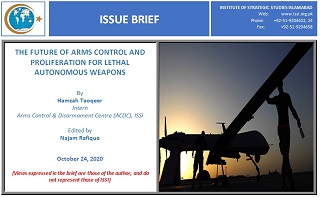Autonomous weapon systems, drone-swarms, smart loitering munitions, fire and forget missile systems are no longer stuff of a science fiction novel but a living reality of the contemporary battlefield. The on-going wars in Syria, Yemen, Libya and conflict between Azerbaijan and Armenia over the Nagorno-Karabakh territory gives a brief glimpse of lethality and destructive capabilities of Lethal Autonomous Weapon Systems (LAWS) in the modern battlefield.[1]
The leaps of advancements in emerging technologies, mainly artificial intelligence (AI), machine learning and data mining have re-invigorated the revolution in military weapons. The introduction of autonomous weapon systems have broadened the magnitude, range and dimensions of operations to track, observe and engage the enemy from a safe distance. In the modern battlefield, the use of unmanned systems along with continuous enhancement in AI have given machines relatively more autonomy and little direct control or observatory role to the human operators. This dimension of maintaining and regulating effective control or keeping humans in the loop has been the major area of debate and a point of concern for international organizations and nation-states, which dread a near-future battlefield where lethal autonomous weapons would be operating on their own.















